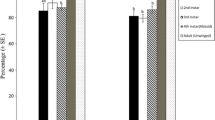Abstract
Encarsia tricolor Foërster is a facultative autoparasitoid that develops on the important pestTrialeurodes vaporariorum (Westwood) in outdoor crop conditions, which makes this aphelinid species promising for biological control programs in regions where field and protected crops coexist.
In this paper we report the results obtained in the study of daily and totalE. tricolor egg laying and of adult female preference for different host stages in which to lay eggs at constant temperatures in the range 10 to 32 °C. Only whitefly nymphs were present in the searching arena (tomato leaflets).
The mean number of eggs laid per female in one day ranged from 4.0 (10 °C and 32 °C) to 15.2 (24 °C). The mean total number of eggs increased with temperature from 10 to 28 °C, reaching a maximum of 123 eggs per female at 28 °C, and decreased sharply from 28 to 32 °C.
The relation between the intrinsic rate of increase (rm) and temperature in the range 10 to 28 °C followed a straight line whose equation was rm=−0.076+0.011*T (R2=0.99). The rm ofE. tricolor was greater than the rm ofT. vaporariorum when temperature was higher than 9.2 °C.
The preference for any particular host instar in which to lay eggs was not always significant. However, N4 was the host instar preferred whenever preference was statistically significant.
Résumé
On présente les résultats obtenus dans l'étude de la fécondité, totale et journalière, d'Encarsia tricolor et de la préférence pour les différents stades de l'hôte (larves deTrialeurodes vaporariorum) dans lesquels déposer les œufs, à différentes températures constantes.
Le maximum d'œufs pondus par femelle par jour va de 6 (à 10 et 32 °C) à 21 (à 28 °C). La moyenne de la ponte totale par femelle va augmenter avec la température de 10 à 28 °C, pour atteindre le maximum de 123 œufs et retomber brusquement à 28 à 32 °C. Le taux intrinsèque de croissance d'E. tricolor fut supérieur à celui deT. vaporariorum au-dessus de 9,2 °C.
La préférence pour un stade hôte particulier dans lequel déposer les œufs n'était pas toujours significative. Mais, quand elle le fût, la larve du quatrième stade a été préférée.
Similar content being viewed by others
References
Ables, J. R. &Shepard, M. — 1976. Influence of temperature on oviposition by the parasitesSpalangia endius andMuscidifurax raptor. —Environ. Entomol., 5, 511–513.
Albajes, R., Casadevall, M., Bordas, E., Gabarra, R. &Alomar, O. — 1980. La mosca blanca de los invernaderos,Trialeurodes vaporariorum, en El Maresme. II. Utilización deEncarsia tricolor [Hym.: Aphelinidae] en un invernadero de tomate temprano. —An. INIA/Ser. Agric., 13, 191–203.
Avilla, J. &Copland, M. J. W. — 1987. Effects of host stage on the development of the faculttive autoparasitoidEncarsia tricolor [Hymenoptera: Aphelinidae]. —Ann. appl. Biol. 110, 381–389.
Avilla, J. &Copland, M. J. W. — 1988. Development rate, number of mature oocytes at emergence and adult size ofEncarsia tricolor at constant and variable temperatures. —Entomophaga, 33, 289–298.
Avilla, J., Artigues, M., Sarasúa, M. J. &Albajes, R. — 1990. A review of the biological characteristics ofEncarsia tricolor and their implications for biological control. —IOBC/WPRS Bull., XIII (5): 14–18.
Arzone, A. — 1976. Indagini suTrialeurodes vaporariorum ed.Encarsia tricolor in pien'aria. —Inf. fitopatol., 11/12, 5–10.
Christochowitz, E. E., van der Fluit, N. &van Lenteren, J. C. — 1981. Rate of development and oviposition frequency ofTrialeurodes vaporariurum, Encarsia formosa (two strains) andE. tricolor at low glasshouse temperatures. —Proc. Int. Symp. Crop Protection, Med. Fac. Landbouww. Rijksuniv. Gent., 46/2, 477–485.
Hilbert, D. W. &Logan, J.A. — 1983. Empirical model of nymphal development for the Migratory Grasshopper,Melanoplus sanguinipes [Orthoptera: Acrididae]. —Environ. Entomol., 12, 1–5.
Hudson, W. G. &Williams, M.L. — 1986. Release of the parasitic wasp,Encarsia lahorensis [Hymenoptera: Aphelinidae], for control of Citrus Whitefly [Homoptera: Aleyrodidae] in Gardenia in Alabama. —Environ. Entomol., 15, 585–589.
Van Lenteren, J. C. — 1986. Parasitoids in the greenhouse: Successes with Seasonal Inoculative Release System. In: Insect Parasitoids (J. Waage &D. Greathead, eds). —Academic Press., London, 341–374.
Van Lenteren, J. C., Nell, H. W., Sevenster-van der Lelie, L. A. &Woets, J. — 1976. The parasite-host relationship betweenEncarsia formosa [Hymenoptera: Aphelinidae] andTrialeurodes vaporariorum [Homoptera: Aleyrodidae]. I. Host finding by the parasite. —Entomol. Exp. Appl., 20, 123–130.
Van Lenteren, J. C. &Hulspas-Jordaan, P. M. — 1983. Influence of low temperature regimes on the capability ofEncarsia formasa and other parasitoids in controlling the greenhouse whitefly,Trialeurodes vaporariorum. —IOBC/WPRS Bull., VI, 54–70.
Logan, J. A. & Weber, L. A. — 1989. Population Model Design System. — Virginia Polytechnic Inst.
Nechols, J. R. &Tauber, M. J. — 1977. Age-specific interaction between the greenhouse whitefly andEncarsia formosa: influence of the parasite on host development. —Environ. Entomol., 6, 207–210.
Tingle, C. C. D. &Copland, M. J. W. — 1989. Progeny production and adult longevity of the mealybug parasitoidsAnagyrus pseudococci, Leptomastix dactylopii, andLeptomastoidea abnormis [Hym.: Encyrtidae] in relation to temperature. —Entomophaga 34, 111–120.
Ratte, H. T. — 1985. Temperature and Insect Development. In: Environmental Physiology and Biochemistry of Insects (K. H. Hoffman, ed.). —Springer Verlag, Berlin, 33–65.
Walter, G. H. — 1983. “Divergent male ontogenies” in Aphelinidae [Hymenoptera: Chalcidoidea]: a simplified classification and a suggested evolutionary sequence. —Biol. J. Lin. Soc., 19, 63–82.
Author information
Authors and Affiliations
Rights and permissions
About this article
Cite this article
Artigues, M., Avilla, J., Sarasua, M.J. et al. Egg laying and host stage preference at constant temperatures inEncarsia tricolor [Hym.: Aphelinidae] . Entomophaga 37, 45–53 (1992). https://doi.org/10.1007/BF02372973
Received:
Accepted:
Issue Date:
DOI: https://doi.org/10.1007/BF02372973



